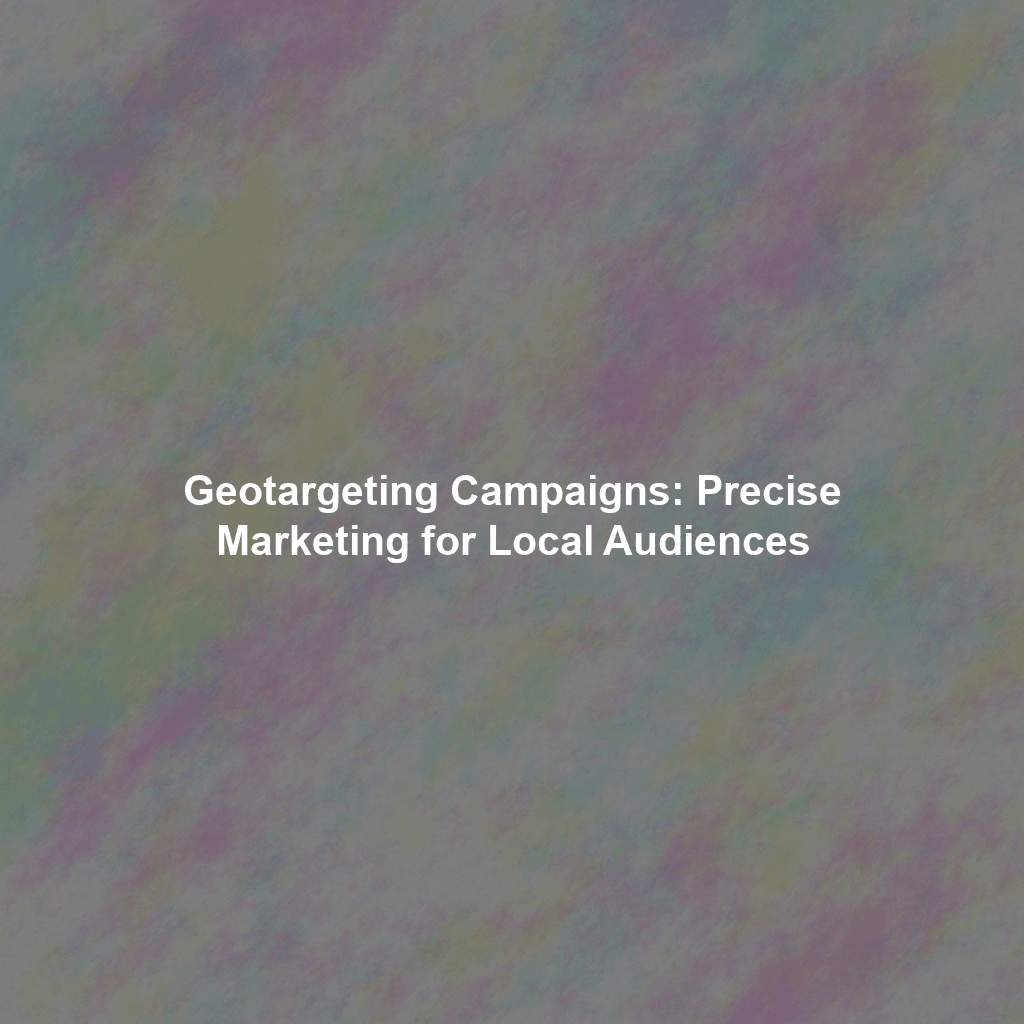The Power of Location: Why “Marketing Near Me” Matters
In today’s digital landscape, the ability to connect with customers precisely where they are is no longer a luxury, it’s a necessity. Think about your own buying habits. How often do you search for “restaurants near me” or “coffee shops open now”? These localized searches are a goldmine for businesses, and “marketing near me” strategies capitalize on this behavior to drive traffic and sales. At the heart of this is geotargeting, a powerful tool that allows you to deliver the right message, to the right people, at the right time, and in the right location.
What is Geotargeting? Defining Precise Marketing
Geotargeting is a digital marketing technique that allows you to deliver tailored content and advertising to users based on their geographic location. This location can be determined through various methods, including:
- IP Address: Identifying a user’s general location based on their Internet Protocol (IP) address. This is often used for broader targeting.
- GPS: Utilizing Global Positioning System (GPS) data from smartphones and other devices for highly precise location targeting.
- Wi-Fi: Using the location of Wi-Fi networks to determine a user’s approximate location.
- Geo-Fencing: Creating a virtual perimeter around a specific location, triggering actions (like sending an ad) when a user enters or exits that area.
- Beacons: Small, Bluetooth-enabled devices that transmit signals to nearby smartphones, allowing for ultra-localized marketing within a store or event.
Instead of casting a wide net and hoping to catch a few fish, geotargeting allows you to use a spear – targeting your ideal customer with incredible accuracy. This results in higher engagement, increased conversion rates, and a better return on investment.
Unlocking the Benefits: Why Implement Geotargeting?
The advantages of geotargeting are numerous and can significantly impact your bottom line. Here are some key benefits:
1. Increased Relevance and Engagement
By delivering content that is directly relevant to a user’s location, you increase the likelihood of them paying attention. Imagine a coffee shop advertising a midday special only to people within a one-mile radius – that’s far more effective than a generic ad shown nationwide.
2. Improved Conversion Rates
Highly targeted ads lead to higher conversion rates. Someone searching for “pizza near me” is clearly ready to order. Showing them a compelling ad with a special offer from a local pizzeria is far more likely to result in a sale than showing them a general pizza advertisement.
3. Reduced Marketing Costs
Instead of wasting resources on reaching irrelevant audiences, geotargeting allows you to focus your budget on potential customers who are actually within your service area. This reduces wasted ad spend and maximizes your ROI.
4. Enhanced Customer Experience
Geotargeting can be used to improve the overall customer experience. For example, you can send personalized welcome messages to customers when they enter your store or provide location-specific recommendations through your app.
5. Competitive Advantage
By leveraging geotargeting, you can gain a competitive edge over businesses that rely on broader, less targeted marketing strategies. You can capitalize on local events, target competitor locations, and build a stronger local presence.
Geotargeting in Action: Real-World Examples
To illustrate the power of geotargeting, let’s look at some concrete examples:
- Restaurant Advertising: A restaurant can target users within a specific radius during lunchtime, promoting daily specials or discounts. They could also target users near competitor locations, tempting them with a better offer.
- Retail Promotions: A clothing store can send push notifications to customers’ smartphones when they are near the store, alerting them to new arrivals or special promotions.
- Event Promotion: A concert venue can target users in the surrounding area with ads promoting upcoming shows, driving ticket sales.
- Real Estate Marketing: Real estate agents can target potential buyers within a specific neighborhood, showcasing available properties and highlighting local amenities.
- Automotive Dealerships: Dealerships can target users within a reasonable driving distance who have recently searched for car models or are nearing the end of their lease agreements.
Implementing Geotargeting: A Step-by-Step Guide
Getting started with geotargeting doesn’t have to be complicated. Here’s a step-by-step guide to help you implement effective geotargeting campaigns:
1. Define Your Target Audience
The first step is to clearly define your target audience. Consider their demographics, interests, and buying habits. Where do they live, work, and spend their time? Knowing your audience is crucial for effective geotargeting.
2. Choose the Right Geotargeting Method
Select the appropriate geotargeting method based on your goals and budget. IP targeting is a good starting point for broader campaigns, while geo-fencing and beacons offer more precise targeting for specific locations.
3. Select Your Marketing Platform
Choose a marketing platform that supports geotargeting. Popular options include:
- Google Ads: Google Ads offers robust geotargeting capabilities, allowing you to target users based on location, demographics, and interests.
- Facebook Ads: Facebook Ads also provides powerful geotargeting options, enabling you to target users based on location, demographics, interests, and behaviors.
- Mobile Advertising Networks: Mobile advertising networks specialize in delivering ads to mobile devices based on location.
- Email Marketing Platforms: Some email marketing platforms allow you to segment your email list based on location and send targeted emails.
4. Create Compelling Content
Develop engaging content that is relevant to your target audience and their location. Use location-specific language and imagery to resonate with local customers. Highlight your local connection and any local benefits you offer.
5. Set Your Budget and Bidding Strategy
Determine your budget and bidding strategy. Consider your desired reach, frequency, and cost per acquisition. Experiment with different bidding strategies to optimize your campaign performance.
6. Track and Analyze Your Results
Monitor your campaign performance closely and analyze your results. Track key metrics such as impressions, clicks, conversions, and return on ad spend. Use this data to optimize your campaigns and improve your targeting.
Geotargeting Strategies: Beyond the Basics
Once you’ve mastered the basics of geotargeting, you can explore more advanced strategies to further enhance your campaigns:
1. Geo-Fencing with Targeted Messaging
Create geo-fences around competitor locations and target users who enter those areas with special offers or promotions. This can be a powerful way to steal customers from your competitors.
2. Time-Based Geotargeting
Combine geotargeting with time-based targeting to deliver the right message at the right time. For example, a coffee shop can target users near their location during the morning rush with ads promoting their breakfast menu.
3. Hyperlocal Targeting with Beacons
Use beacons to deliver highly personalized messages to customers within your store. For example, you can send welcome messages, product recommendations, or special offers based on their location within the store.
4. Mobile App Geotargeting
If you have a mobile app, leverage geotargeting to deliver location-specific content and promotions to your app users. This can improve engagement and drive sales.
5. Geotargeting for Local SEO
Optimize your website and online listings for local search. Use location-specific keywords and ensure your business information is accurate and consistent across all platforms. This will help you rank higher in local search results and attract more customers from your area.
Overcoming Challenges: Avoiding Common Geotargeting Pitfalls
While geotargeting offers many benefits, it’s important to be aware of potential challenges and pitfalls:
- Accuracy Issues: Location data is not always 100% accurate. IP addresses can be imprecise, and GPS signals can be affected by buildings or other obstructions.
- Privacy Concerns: Be transparent about how you are collecting and using location data. Provide users with options to opt out of location tracking.
- Over-Targeting: Avoid being too aggressive with your targeting. Bombarding users with too many ads can be annoying and counterproductive.
- Irrelevant Content: Ensure your content is relevant to the user’s location and interests. Generic or irrelevant ads will be ignored.
The Future of “Marketing Near Me”: Trends and Predictions
“Marketing near me” and geotargeting are constantly evolving. Here are some trends and predictions to watch out for:
- Increased Use of AI and Machine Learning: AI and machine learning will play an increasingly important role in geotargeting, enabling marketers to personalize ads and optimize campaigns in real time.
- Augmented Reality (AR) Integration: AR will be used to enhance the customer experience with location-based content and promotions.
- Focus on Privacy and Transparency: Consumers will demand greater transparency and control over their location data. Marketers will need to prioritize privacy and build trust with their customers.
- More Granular Targeting: Geotargeting will become even more granular, allowing marketers to target users based on specific behaviors and interests within a particular location.
Conclusion: Mastering Geotargeting for Local Success
Geotargeting is a powerful tool that can help you reach local audiences with precision, improve your marketing ROI, and gain a competitive edge. By understanding the principles of geotargeting, implementing effective strategies, and staying up-to-date with the latest trends, you can unlock the full potential of “marketing near me” and drive significant growth for your business. The key is to provide valuable, relevant, and timely information to your target audience based on their current location. Do that, and watch your local marketing efforts thrive.
 Skip to content
Skip to content

